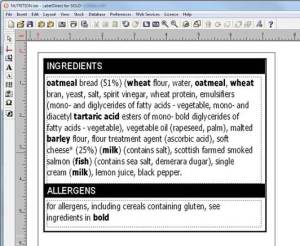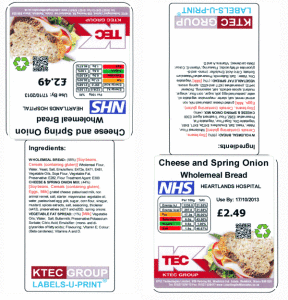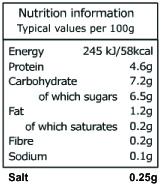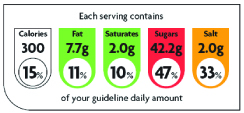 The new EU regulations on the provision of food information to consumers changes existing legislation on food labelling including:
The new EU regulations on the provision of food information to consumers changes existing legislation on food labelling including:
- Highlighting allergens e.g. peanuts or milk in the list of ingredients; also covers non pre-packed foods including those sold in restaurants and cafés.
- Better legibility i.e. minimum size of text;
- Mandatory nutrition information on processed foods;
- Mandatory origin labelling of unprocessed meat from pigs, sheep, goats and poultry;
Here are some suggestions for each requirement……
- HIGHLIGHTING (BOLDING) ALLERGENS
For ‘Highlighting allergens’ some will call this ‘bolding’ of allergens as it’s the simplest way to do the highlighting.
Some of our customers in cafes and sandwich makers who have the SOLO stand-alone labelling printer with keypad can use the new SOLO2 system with ‘bolding’ capability and keep the stand-alone capability. Read More…
For users of BarTender labelling software, upgrading to the latest version has the capability to add ‘bolding’ of allergens in two ways. Read More…
-FOOD MANUFACTURING SYSTEM (FMS)
If you would rather jump to an integrated food recipe system that updates all your labels in a few seconds whenever you alter an ingredient, then take a look at the FMS system. FMS automatically ‘manages’ all your labels by inserting the correct titles and ingredients as full composition with all the correct bolding of allergens, QUID % for key ingredients as well as capability to add readymade Nutrition Icons that display the Recommended Daily Allowance (RDA) or each key nutrition and or the TRAFFIC LIGHT summary of the main nutrition’s, and or the full table of Energy and Nutrition’s for that meal. Read More….
- BETTER LEGIBILITY
Traditionally some users have old label printers with limited dots per inch capability like 200 or 300 dpi thermal transfer printers for example. These can’t print small characters. Note that different fonts can give rise to different character heights. This Guidance is based on an 8 point font size having the lower case letter ‘o’ with a height of 1.6 mm.
With more and more information needing to be printed on the label there is less space available and either the label has to be made larger or the type made smaller and more of it. There is a move toward using 600dpi thermal transfer printers or better still laser printers having 1200 or 2400 dpi or ink jet printers have the ultimate print quality of 4800dpi. If moving to laser or ink jet printing there are advantages of being able to add all the information in full colour and high quality print dpi so small but very legible text and high quality pictures are all possible.
- NUTRITION INFORMATION
The addition of basic Energy and Nutrition information on pre-packed foods is mandatory. As well as Energy per 100g producers will include the top 6 Nutrition’s - Protein, Carbohydrate, Fat, Fibre, Sodium and Salt as a table with values in kJ / Kcal for energy and grams for each of the Nutrition’s. This is easily done in black on a thermal transfer printer though again more space is required for the Nutrition panel and may be a move to a 600dpi printer like the TOSHIBA TEC B-EX4T2-HS12 is needed to get the small size print and with clarity. Since there is a growing directive to use colour to indicate warnings for levels of Nutrition then a colour printer will tick all the boxes bringing small legible text, colour Nutrition indicators and full colour pictures and logos in one go.
- MEAT ORIGIN LABELLING
This is usually either to help with traceability say for a catering butcher and for informing customer of the country of origin of the meat. I have provided labelling systems used in meat cutting plants that label cuts of meat with details of the product as well as details about where the animal was slaughtered and cut and processed. Each processing plant is registered in Europe and its common practice now and law in many countries to display the registered plant number for each processing stage like Born In: IRELAND, Raised In: IRELAND; Slaughtered In: UK, Cut In: SCOTLAND, and clearly displaying the EU Slaughter House and Cutting Plant Numbers, manufacturing date, expiry date and the like. Barcodes are a good way to uniquely label boxes of meat that is then further cut into labelled portions with each portion label acquiring linked to the parent animal carcass for backwards traceability in case of any problems as well as showing the end customer details of the meats country of origin for example.
For more guidance on food labelling see the FOODS STANDARDS AGENCY - FOOD LABELLING – CLEAR FOOD LABELLING GUIDANCE document here……





